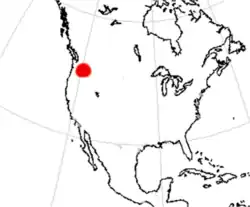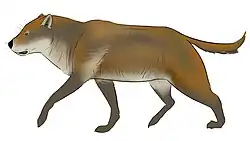Rhizocyon
| Rhizocyon Temporal range: early Oligocene
| |
|---|---|
| Scientific classification | |
| Kingdom: | Animalia |
| Phylum: | Chordata |
| Class: | Mammalia |
| Order: | Carnivora |
| Suborder: | Caniformia |
| Family: | Canidae |
| Subfamily: | †Borophaginae |
| Genus: | † Wang, Tedford, & Taylor, 1999 |
| Species: | †R. oregonensis
|
| Binomial name | |
| †Rhizocyon oregonensis (Merriam, 1906)
| |

| |
| Range of Rhizocyon based on fossil distribution | |
Rhizocyon ("root dog") is an early member of the subfamily Borophaginae, an extinct subgroup of canids that were endemic to western North America during the Oligocene epoch, living from ~31—24.5 Ma., existing for approximately 6.5 million years.
Rhizocyon was similar to a contemporary species, Archaeocyon leptodus, from the Great Plains, but it shows a few subtle differences in the structure of the skull and dentition that indicate that Rhizocyon may be close to the ancestry of later borophagines. Only a single species, R. oregonensis, is known and all fossils come from the John Day Formation in Oregon.
References
- Wang, Xiaoming., R.H. Tedford, and B.E. Taylor. 1999. Phylogenetic systematics of the Borophaginae (Carnivora, Canidae). Bulletin of the American Museum of Natural History, 243:1-391.
- Balisi, Mairin and B. Van Valkenburgh. 2020. Iterative evolution of large-bodied hypercarnivory in canids benefits species but not clades. Communications Biology 3(461).
.png)


_-_N._donnezani.png)
_-_V._praeglacialis.png)
.jpg)

_-_C._a._europaeus.png)
_-_C._mosbachensis.png)
_-_C._l._spelaeus.png)